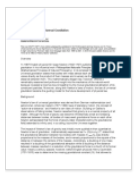Citation:

Abstract:
In 1687 English physicist Sir Isaac Newton (1642-1727) published a law of universal gravitation in his influential work Philosophiae Naturalis Principia Mathematica (Mathematical Principles of Natural Philosophy). In its simplest form, Newton's law of universal gravitation states that bodies with mass attract each other with a force that varies directly as the product of their masses and inversely as the square of the distance between them. This mathematically elegant law, however, offered a remarkably reasoned and profound insight into the mechanics of the natural world because revealed a cosmos bound together by the mutual gravitational attraction of its constituent particles. Moreover, along with Newton's laws of motion, the law of universal gravitation became the guiding model for the future development of physical law.
Newton's law of universal gravitation was derived from German mathematician and astronomer Johannes Kepler's (1571-1630) laws of planetary motion, the concept of "action-at-a-distance," and Newton's own laws of motion. Building on Galileo's observations of falling bodies, Newton asserted that gravity is a universal property of all matter. Although the force of gravity can become infinitesimally small at increasing distances between bodies, all bodies of mass exert gravitational force on each other. Newton extrapolated that the force of gravity (later characterized by the gravitational field) extended to infinity and, in so doing, bound the universe together. more
